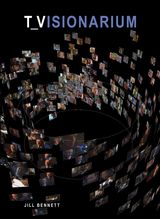 Jill Bennett ,
Jill Bennett ,
T_Visionarium: A User's Guide
Sydney , UNSW Press , 2008 (pp. 64) ISBN 0868409359
Jill Bennett's book, T_Visionarium: A User's Guide is an important exposition about the new world of interactive media, which are being shaped and formed by technologies that move the experience of viewing far beyond its conventional boundaries.
The book is essentially an exploration of an innovative immersive installation developed at the University of New South Wales. The book is accompanied by a DVD, which shows in greater detail how T_Visionarium works and also has interviews with the inventors, Jeffrey Shaw and co-director, Neil Brown.
The issue at the heart of the book is whether T_Visionarium represents a genuine shift in the ways in which spectators relate to moving images and whether the architectural reinvention of the cinematic viewing space leads to a more interactive relationship to large numbers of images and stories.
T_Visionarium looks like an out-sized version of the original Daedalum, a stroboscopic device invented by William Horner and renamed the Zoetrope in 1867 by William Loncoln. T_Visionarium is a giant cylinder with an interior onto which thousands of images can be projected. Viewers wear 3-D glasses to interact with the images and have controllers that allow for the images to be resized and moved around.
Aside from the fact that T_Visionarium transforms the theatrical environment so that viewers can reorganize the spatial and temporal relationship they have with images, it also permits and encourages spectators to break away from conventional, and often linear types of interactions, with television and the cinema.
Bennett’s book makes many claims about the transformative impact of this project. Perhaps the most important is that T_Visionarium is a moment in the history of the media that points towards a new form of television criticism and analysis. The experience of manipulating and interacting with the database enables the participant to develop a radically different sense of the ways images communicate, their context and the flow of relationships that develop between them. As a result, audiences, relate to the images through a simulated physical interaction with them.
Transcription, redescription, mashing — all of these elements become fundamental to the experiences of interaction and drive participants into a new realm of critical engagement. The T_Visionarium allows viewers to become editors as they search through snippets of dialogue, narrative and visual documents. These new editors can build and rebuild the database as well as the information that underlies it.
I wish that Bennett had written this book with greater clarity. Notwithstanding some language that needed editing, the book is a valuable contribution to debates about technology, imaging and the new terrain of experiences that T_Visionarium makes possible. There is a wonderful utopianism to the experiment, returning us on the one hand to early 19th century participatory experimentation, while at the same time giving us a peak at what will surely be one of the foundation upon which emerging forms of cinematic and televisual expression will depend.
For more information about T_Visionarium visit http://www.icinema.unsw.edu.au/projects/infra_avie.html
About the Author
Professor Ron Burnett is Vice Chancellor and President of Emily Carr University of Art and Design. He is an adjunct Professor at York University, Canada and author of two books Cultures of Vision: Images, Media and the Imaginary, and How Images Think as well as over 150 published articles and book chapters. His blog can be found at http://www.ecuad.ca/~rburnett/Weblog/

